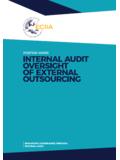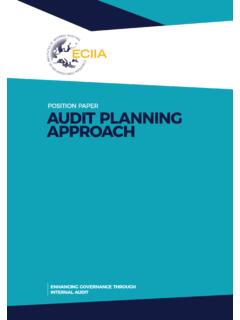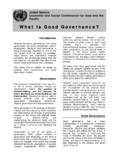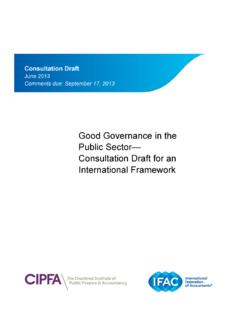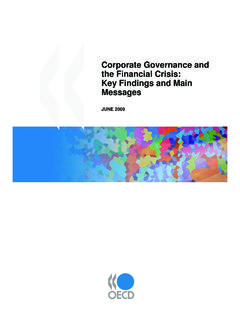Transcription of POSITION PAPER INTERNAL AUDIT’S ROLE IN GOOD …
1 INTERNAL AUDIT S ROLE IN good GOVERNANCEPOSITION PAPERENHANCING governance THROUGHINTERNAL AUDITP osition PAPER | INTERNAL audit s role in good governance2 CONTENTS3 INTRODUCTION Thesis Background4 FUNDAMENTALS INTERNAL audit s strategic and distinctive role Responsibilities of the parties involved in the system of INTERNAL control Scope and scale of INTERNAL audit evaluation INTERNAL audit risk-based approach Independence of INTERNAL audit, to evaluate risk and control functions effectiveness Reliance on other risk and control functions INTERNAL audit conclusions and opinions INTERNAL audit contribution to the improvement of INTERNAL and external reporting10 APPENDIX Main referencesThe European Confederation of Institutes of INTERNAL Auditing (ECIIA) is the professional representative body of 35 national institutes of INTERNAL audit in the wider geographic area of Europe and the Mediterranean basin.
2 The mission of ECIIA is to be the consolidated voice for the profession of INTERNAL auditing in Europe by dealing with the European Union, its Parliament and Commission and any other appropriate institutions of influence. The primary objective is to further the development of corporate governance and INTERNAL audit through knowledge sharing, key relationships and regulatory environment Head Office: c/o IIA BelgiumK o n i n g s s t r a a t 10 9 -111 Bus 5, BE 1000 Brussels, BelgiumPhone: +32 2 217 33 20 Fax: +32 2 217 33 20 TR: ECIIAP osition PAPER | INTERNAL audit s role in good governance3 INTRODUCTIONECIIA set up a Banking Committee in 2015 with Chief Audit Executives of European Central Bank Supervised Banks1. See the European Central Bank website for a full list of supervised mission of the ECIIA Banking Committee is: To be the consolidated voice for the profession of INTERNAL auditing in the Banking Sector in Europe by dealing with the European Regulators and any other appropriate institutions of influence and to represent and develop the INTERNAL Audit profession and good Corporate governance in the Banking Sector in Europe The PAPER describes best practice from the practitioners, but it is important to note that, depending on the culture, size, business and local requirements, other options are possible.
3 Thesis INTERNAL control is an important cornerstone for banks long-term sound governance . It should be tailored to the business model, risks and organisational structure. As risks are more and more complex, there are several functions involved in the implementation and the evaluation of an INTERNAL control system. However, it is important to stress the distinctive contribution of INTERNAL audit functions. Indeed, as the third line of defence, reporting to senior management and the board, INTERNAL audit gives an overall assurance on INTERNAL control effectiveness including an independent review of risk and control functions as well as insights on efficiency. 1 Chief Audit Executives from DZ Bank AG, Cr dit Agricole SA, ABN AMRO, Grupo Santander, UniCredit , KBL European Private Bankers, Nordea, National Bank of The other component being the remuneration framework as stated in GL44 from bank s INTERNAL control system is, with its risk governance , one of the two components2 of its governance framework.
4 There are several functions involved in risk mitigation, reporting and communicating to senior management and the board. Clear accountability of each function must be established with reference to the three lines of defence model: Under the first line of defence, operational management has ownership, responsibility and accountability for assessing, controlling and mitigating risks as well as executing corrective actions. The second line of defence consists of several functions (compliance, risk management, controllership and other functional departments) that monitor and facilitate the implementation of effective risk mitigation by operational management. These functions support ongoing controls including the industrialisation of automated controls. As the third line of defence, an independent INTERNAL audit function provides, through a risk-based approach, assurance to the organisation s board and senior management on the quality, consistency and effectiveness of a bank s INTERNAL control, risk management and governance systems including the adequacy of the first and second lines of design and the implementation of INTERNAL control within this organisational structure are under the scrutiny of the board and senior management.
5 For these oversight responsibilities, they can rely on INTERNAL audit, whose strategic role is recognised in regulatory and professional requirements. Among other things, INTERNAL audit is the best placed to enhance transparent PAPER | INTERNAL audit s role in good governance4 FUNDAMENTALSTo achieve their mission regarding the efficiency and effectiveness of INTERNAL control and for greater added value, INTERNAL auditors need clear specification and recognition of: INTERNAL audit s strategic and distinctive roleTo avoid any confusion, it should be explicitly stated that within the risk and control functions , INTERNAL audit has a unique input: It provides an independent and objective assurance to the highest level of the institution. It gives to board and senior management insights about the overall INTERNAL control system at the entity, activity and transaction levels. Through its comprehensive approach, INTERNAL audit challenges the risk-taking environment, the resource and competence in place with respect to the institution s vision, and even the integrity of the methods and techniques.
6 Unlike other lines of defence, INTERNAL audit is not involved in designing, selecting, establishing and implementing specific INTERNAL control policies, mechanism and procedures and risk limits. More than just attesting the execution of a specific rule or procedure, INTERNAL auditors assess the design adequacy, operating effectiveness, compliance, efficiency, accuracy and transparent reporting of INTERNAL controls as regarding the bank s risk profile and , the INTERNAL audit function should be particularly well positioned to have a clear understanding of the organisation mission, vision, strategy and long-term goals (cf. Basel Committee principles regarding INTERNAL audit). INTERNAL audit should not be combined nor merged with any other of the parties involved in the system of INTERNAL controlInternal audit role must be sustained by: A documentation of the respective responsibilities of relevant board committees (Audit Committee and Risk Committee) regarding the system of INTERNAL control, their coordination and the interaction with the Chief Audit Executive.
7 Clear accountability of each line of defence regarding the control environment (cf. EBA guidance on INTERNAL governance ). Some organisations choose to formalise these roles in a charter and/or an assurance map. Interactions between the second and third line of defence allowing optimal scope coverage. For example: Coordination between the second line of defence functions could be organised within a committee chaired by an executive senior manager who takes decisions for the improvement of INTERNAL controls. In participating in this committee, the Chief Audit Executive can give some advice but doesn t take part in decisions to avoid being judge and jury. INTERNAL audit reliance on other risk and control functions. After an independent assessment of their effectiveness, the Chief Audit Executive can decide to rely on some works from the second line of defence functions to reduce INTERNAL audit routine and permanent engagements and to enhance its risk-based approach.
8 Leveraging first and second lines of defence remote and continuous controls, as well as mass data analysis, provided that the reliability of the process and of data is confirmed. Even so, INTERNAL auditors are not expected to use these tools on a day-to-day basis. Additional work to enhance the level of reliance. When the Chief Audit Executive judges that he cannot rely on other parties work due to insufficient objectivity (conflict of interest, inadequate reporting relationship), competencies, methodology (from the planning stage) or reliable and relevant evidence, he is entitled to plan additional works. Cooperation and mutual information sharing between INTERNAL audit and external audit, for example about the relevance of accounting methods as regarding safety and prudence objectives, for instance IFRS 9 and hedge accounting. Nevertheless, the outsourcing from external audit to INTERNAL audit is forbidden.
9 POSITION PAPER | INTERNAL audit s role in good governance5 Scope and scale of INTERNAL audit evaluationInternal audit assessment of INTERNAL control is not limited to administrative and accounting procedures but covers a broad scope (principles, policy, structure, reporting and control framework including the first and second lines of defence). In assessing organisational culture, structure, resources, tools, method and reporting, INTERNAL audit reviews several aspects such as: the adequacy of the institution s governance framework in achieving its strategic objectives; the design of policies and procedures in compliance with mandatory requirements, relevant INTERNAL decisions and risk appetite; the quality and efficiency of INTERNAL controls implemented by the first and the second lines of defence as well as their risk mitigation escalation process as regarding the bank s strategy including its risk doing so, INTERNAL audit provides reliable assurance and insight about the achievement of the bank s operational, reporting and compliance objectives at the entity, activity and transaction audit risk-based approachTo determine the priorities of the INTERNAL audit function regarding the INTERNAL control system, the Chief Audit Executive develops a risk-based plan.
10 He considers inputs from senior management and the board and obtains an understanding from the organisation s strategies, key business objectives, trends and emerging issues that could impact the organisation. As part of this planning, INTERNAL audit needs to have a continuous and unfettered access to relevant committees and resources to cover a broad scope (risk and compliance functions, key issues linked to the business model including outsourced services, IT (cybersecurity, big data, mobile devices)). At the engagement level, INTERNAL auditors use adequate evaluation criteria such as INTERNAL policies and procedures, external legal and regulatory requirements, and leading industry-specific or professional of INTERNAL audit, to evaluate risk and control functions effectivenessThis assessment includes organisational structure, resources, tools, method and reporting aspects as well as the proper coordination with other lines of defence functions to allow an effective coverage of the institution s risks.

